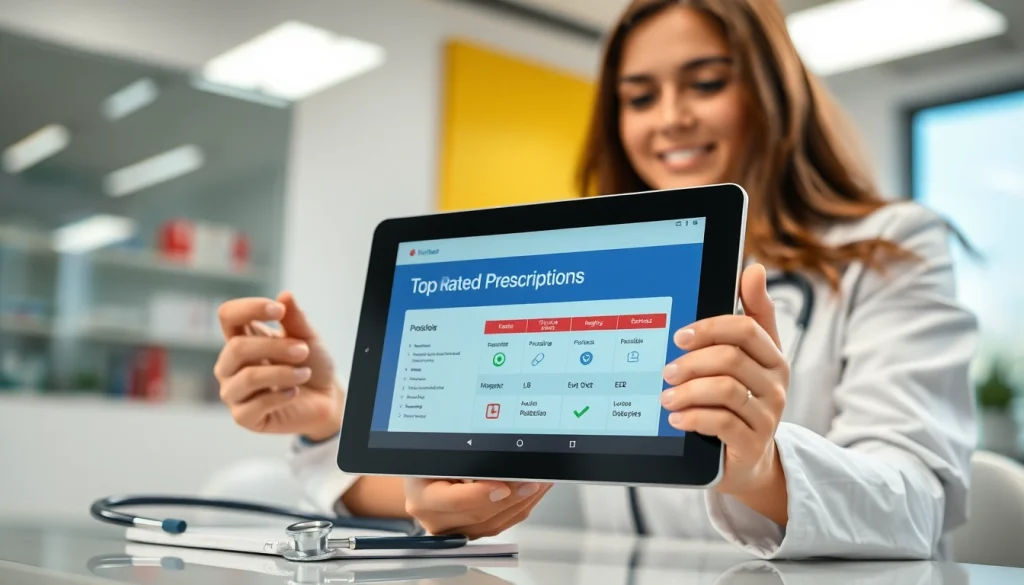
Understanding Top Rated Prescription Applications
Defining Prescription Applications
Prescription applications, often referred to as prescription apps, are innovative digital tools designed to streamline the medication management process for healthcare providers and patients alike. These applications provide a range of functionalities, including medication tracking, prescription refills, and communication with healthcare professionals. By leveraging technology, they enhance patient adherence, improve health outcomes, and facilitate easier and safer medication management.
Importance of Top Rated Prescription Applications
In an era where digital solutions are increasingly integrated into everyday life, the significance of top rated prescription applications cannot be overstated. These applications not only make it easier for patients to manage their medications but also improve the efficiency of healthcare providers. Features such as instant access to prescription information, reminders for dosages, and seamless communication channels promote patient engagement and adherence. Moreover, during challenging times such as the COVID-19 pandemic, the ability to manage prescriptions remotely has become indispensable.
Key Trends in Prescription Applications
The landscape of prescription applications is constantly evolving. Current trends reflect an increasing focus on user experience, data security, and integration with healthcare systems. Additionally, advancements in mobile technology and artificial intelligence are leading to smarter applications that anticipate user needs and enhance clinical decision-making.
Features of Top Rated Prescription Applications
User-Friendly Interface
A crucial aspect of any successful prescription application is its user interface. A user-friendly interface ensures that patients of all ages and technical abilities can navigate the app with ease. Features such as clear layouts, logical navigation, and helpful tutorials play a significant role in enhancing user experience. Moreover, customization options allow users to tailor the app according to their preferences, further improving their engagement with the tool.
Integration with Healthcare Systems
Integration with existing healthcare systems and electronic health records (EHRs) is vital for ensuring that prescription applications seamlessly fit into the healthcare ecosystem. This integration allows for real-time updates of patient records, better coordination among healthcare providers, and improved accuracy in medication dispensing. When these applications can pull and push data to EHRs, it reduces the likelihood of errors and enhances patient safety.
Medication Management Tools
Top rated prescription applications often include a variety of medication management tools. These can range from simple dosing reminders to advanced tracking systems that monitor patients’ adherence to prescribed treatment plans. Some apps also offer features like drug interaction checks and refill alerts, which empower patients to stay informed about their medication regimens and avoid potential health complications.
Choosing the Right Top Rated Prescription Applications
Evaluating Application Security
Security is a paramount concern when dealing with personal health information. Users should prioritize applications that employ encryption, two-factor authentication, and strict privacy policies to protect their data. Checking for compliance with regulations such as HIPAA (Health Insurance Portability and Accountability Act) can offer additional reassurance regarding the app’s security posture.
Considerations for User Experience
When evaluating potential prescription applications, user experience should be a major consideration. This includes assessing the application’s design quality, ease of navigation, and how intuitively it presents information. Apps that include user-centric design tend to achieve higher satisfaction ratings and promote more consistent usage patterns among patients.
Feedback from Healthcare Professionals
Insights from healthcare professionals who actively use prescription applications can be invaluable. Feedback from practitioners regarding the application’s effectiveness in real-world clinical settings can guide users in making informed choices. Engaging in forums or communities dedicated to healthcare technology can also provide diverse perspectives on the most effective applications in the market.
Implementing Top Rated Prescription Applications in Practice
Training Staff and Users
A successful implementation of prescription applications depends greatly on training for both staff and users. Healthcare providers should offer comprehensive training sessions that cover the functionalities of the application, addressing common challenges and demonstrating best practices. Patients should also be provided with resources and support to help them navigate the app confidently.
Using Applications for Patient Engagement
Top rated prescription applications can serve as powerful tools for elevating patient engagement. Features like personalized notifications, progress tracking, and educational resources can motivate patients to take an active role in their health management. Techniques such as gamification—where users earn rewards for maintaining adherence—can also enhance engagement levels while making medication management more interactive and enjoyable.
Monitoring Effectiveness and Outcomes
Monitoring the effectiveness of prescription applications is critical for continuous improvement. Healthcare providers should establish metrics to evaluate how well the application contributes to medication adherence, patient satisfaction, and overall health outcomes. Regular assessments and updates based on user feedback and clinical results can help ensure that the application remains aligned with user needs and healthcare goals.
Future of Top Rated Prescription Applications
Technological Innovations Ahead
The future of top rated prescription applications is likely to be shaped by ongoing technological innovations. Advances in artificial intelligence, machine learning, and big data analytics have the potential to provide deeper insights into patient behavior, enabling more effective personalization of treatment plans. Future applications could feature predictive analytics that alert patients and clinicians to potential issues before they become serious.
Impact of Artificial Intelligence
Artificial intelligence (AI) is set to play a transformative role in the functionality of prescription applications. From natural language processing that guides patients through queries to intelligent algorithms that suggest alternative treatments based on patient history, AI can streamline the prescribing process and promote better interactions. Incorporating AI can also enhance medication safety by predicting adverse reactions or interactions based on individual patient data.
Expanding Accessibility for Patients
As technology advances, ensuring accessibility across diverse demographics will be key to the success of prescription applications. Efforts to make applications available in multiple languages, compatible with different devices, and tailored for various populations, including seniors and those with disabilities, will enhance their usability and reach. Focusing on inclusivity not only benefits patients but can also lead to improved health outcomes across different communities.






